Introduction The veterinary activities in the Central Rift region went on successfully, two giraffes were desnared in Crater Lake sanctuary in Naivasha and a postmortem examination done on a rhino that died in Kigio ranch
Introduction
The veterinary activities in the Central Rift region went on successfully, two giraffes were desnared in Crater Lake sanctuary in Naivasha and a postmortem examination done on a rhino that died in Kigio ranch. The other main activity was the translocation of Impalas from Lake Nakuru National park to Ndeere Island in Kisumu and Mt. Elgon National park further details of these activities are included in the report.
Rescue of snared Giraffes in Crater Lake sanctuary in Naivasha
These were cases reported by the sanctuary management, one of the giraffes affected was an adult female the had a tight wire at the fetlock region of the right hind limb. It was then captured by chemical restrain and the wire removed, the animal was then released back to the wild successfully. 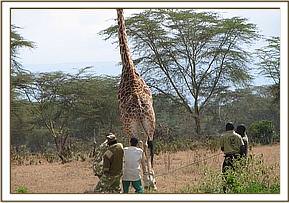
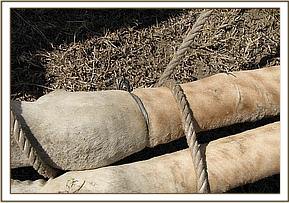

A case of snared giraffe in Naivasha
The other case was that of an adult male giraffe that had a loose snare wire on right hind limb just above the hoof, it had not inflicted any injury to the animal but it affected its movement and feeding. The animal was then captured by chemical restrain and the wire removed.

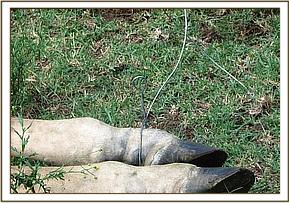

POSTMORTEM EXAMINATION OF A WHITE RHINO (Ceratotherium simum) IN KIGIO WILDLIFE CONSERVANCY:
INTRODUCTION
Kigio Wildlife conservancy is in Naivasha area, it borders Marula and KARI ranches in the North lake side. The ranch had two White rhinos that were introduced there from Lewa Wildlife Conservancy in the year 2003 to help promote tourism activities in the area. The rhinos have been in good condition and well protected until 9/12/07 when the manager reported to KWS veterinarian that the male rhino was seemingly ill, the management was then advised to monitor the animal for some time before the veterinarian arrived but shortly afterwards it was found dead. There was no any form of injury to the animal and it was in a very good body condition when it died, no signs of struggle at the site of death. Postmortem examination was then carried out and the findings were as indicated below.
ANIMAL IDENTIFICATION
Name…………………………..Sligoi
Sex……………………………..Male
Age…………………………….6 years
Location………………………..Kigio Wildlife Conservancy
Approximate body weight……..1400Kgs
Body condition score…………..4
Date reported sick……………...8/12/07
Date of death…………………...9/12/07
Date of postmortem…………….9/12/07
CLINICAL OBSERVATIONS
Shortly before the animal died it was weak, anorexic, no much movement, abduction of front legs, no defecation for a long time. A few hours later the animal suddenly collapsed and died while in the company of the other female rhino. Just before postmortem the animal was exuding white foamy discharges from the nostrils. 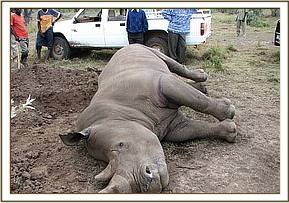

POSTMORTEM EXAMINATION
The KWS rangers being assisted by the conservancy workers and other staff helped the vet to open up the carcass for detailed postmortem. Human safety and precaution was the number one priority and everyone put on protective gear (hand gloves, overall, face masks and gum-boots), the animal was handled with great care.
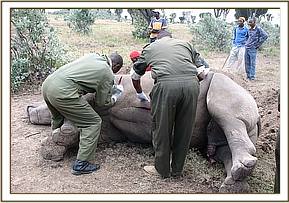
SIGNIFICANT FINDINGS
There was marked pulmonary oedema and congestion, excessive blood and white froth oozing from the bronchi and bronchioles, much of the froth was flowing freely through the trachea to exit through the nostrils. The spleen was thin, flabby and pitting on palpation, thin cardiac muscles, gelatinous/fatty tissue was also found lodged in the left heart ventricle. 
TENTATIVE DIAGNOSIS
Congestive heart failure probably caused by stenosis of pulmonary vein or fat deposits in the lumen of pulmonary vein or on the heart valves. Therefore there was insufficient flow of oxygenated blood from lungs to heart through pulmonary vein hence low supply of oxygenated blood to the brain and other parts of the body.
CAUSE OF DEATH
Pulmonary oedema that led to insufficient oxygenation of blood and lack of oxygen supply to the brain caused brain cells death and finally death of the animal. Asphyxiation would have occurred and that explains why the animal was seen abducting the front legs in an attempt to breathe. The excessive fluid in the lung tissues mixed with air trapped within the lung tissues formed the white froath that was seen exuding through the nostrils after death.
FURTHER INVESTIGATIONS
Tissue samples from all the internal organs were collected for histopathology examination, stomach and intestinal contents collected for toxicological tests.
CARCASS DISPOSAL
The carcass was disposed of by deep burial in 5 feet pit within the ranch.
TRANSLOCATION OF IMPALAS (Aepyceros melampus) FROM LAKE NAKURU NATIONAL PARK TO NDEERE ISLAND, KISUMU IMPALA SANCTUARY AND MT. ELGON NATIONAL PARKS:
BACKGROUND INFORMATION
The Kisumu Impala sanctuary have indigenous population of impalas that were collected and brought together from the areas surrounding Kisumu town. The animals have remained in the sanctuary since 1980s their population has been increasing over the years despite the fact that the parent stock was too small. Chances of in-breeding have increased over the years and it was suspected that the population may soon die out if no rejuvenated by bringing in animals with different genetic backgrounds. Ndeere Island has a small population that was taken there from Kisumu Impala sanctuary in early 1990s, the island can support more impalas and attract tourists. Mt. Elgon National Park has two breeding herds of impalas that should also be improved by bringing in more animals. It against this background that the recent impala translocation was initiated.
OBJECTIVES OF THE TRANSLOCATION
The main objectives for the Impala translocation exercise was to improve the genetic pool of the indigenous impalas in Kisumu Impala sanctuary to reduce the level of in-breeding in that population and also to increase the impala population in Mt. Elgon NP and Ndeere Island. This is meant to create a sustainable breeding population of impalas that will enhance tourism activities in these areas. The objectives were achieved by;
- Introducing a new population of males from Lake Nakuru National Park that are genetically different from the existing impala population in Kisumu Sanctuary to control the effects of in-breeding in the indigenous population in Kisumu.
- Removal of some of the male impalas from Kisumu sanctuary to Mt. Elgon National Park to reduce the level of competition for breeding with new males from Nakuru.
- Increase the population of impalas in Ndeere Island to a sustainable breeding population that can march the carrying capacity of impalas on the Island and enhance tourism activities in the region.
- Reinforce the two breeding herds of impalas in Mt. Elgon National Park by introducing more female impalas from Lake Nakuru National Park and more males from Kisumu impala sanctuary.
MATERIALS AND EQUIPMENT USED IN THE TRANSLOCATION
- Two Toyota Land cruiser vehicles.
- One Canter lorry fitted with a wooden transportation crate.
- Speed boats and canoes.
- Saw dusts
- Sisal sacks
- Plastic tubings
- Capture nets and associated items.
- Dart guns and veterinary drugs
- Blood and tissues sampling kit
- Mega-lights and sportlights.
- GPS machines and cameras
- Protective clothing like overalls, gloves and gumboots
- First-Aid kits
CAPTURE METHOD
The impala herds to be captured had to be assessed during the day to ascertain their numbers, sex, age structure and terrain. The preference was to capture males and females on different occasions to avoid mixing males and females in one container because males can fight and injure females during transport. Once the capture site was identified, nets were erected to form an oval shape with one end open to allow entry of animals into the net. Other drop nets were erected within the main enclosure to help capture animals that attempted to escape.
The best time to capture impalas was at night, a time when they don’t see the nets when chased by vehicles. The animals would then be directed into the nets by vehicles, when impalas get entangled by the nets they would be restrained physically by hand and ropes where necessary.
LOADING AND TRANSPORTATION EXERCISE
The animals were loaded individually by hands into a wooden container fitted onto a canter lorry, the floor of the container was filled with sawdust upto about 6 inches to avoid leg injuries during transport. For male impalas, plastic tubes were fitted on both horns to avoid fights and injuries while put together in the transportation container. Identification marks such as ear-notch were made whenever it was necessary. The animals were transported at night from Nakuru to Kisumu and released in the morning.
ITINERARY
Date
Activity
Remarks
10/12/07
Capture team and veterinarians arrives at Lake Nakuru NP to begin the translocation exercise.
Welcomed by Area AD and research scientist
11/12/07
Twenty seven (27) female impalas captured at LNNP at a GPS location; 37M 0177230, UTM 9950864
Capture and loading process successful
12/12/07
Seventeen (17) impalas released alive in Ndeere Island NP, they were transported by boats while wrapped in sisal sacks to the island.
Ten (10) impalas died while being moved across to the island or while in the lorry waiting for the boat.
13/12/07
Eleven (11) male impalas captured and moved to Mt. Elgon NP at night.
No incidences or mortalities
14/12/07
Capture team traveled from Mt. Elgon NP to LNNP to get more animals.
15/12/07
Fourteen (14) impalas (3 males and 11 females) captured at LNNP at GPS location; 37M0175194, UTM 9951912 and moved to Mt. Elgon NP at night. Eleven females released in Mt. Elgon while 3 males taken to Kisumu impala sanctuary.
Three males taken to Kisumu died of joint injuries and lameness while trying to move on the stony hill after release.
16/12/07
Capture team spent night in Kisumu while monitoring the progress of released impalas
17/12/07
Capture team traveled from Kisumu to LNNP to get more male impalas
18/12/07
Twelve (12) male impalas captured in LNNP at a GPS location; 37M 0175166, UTM 9950098 and moved to Kisumu at night.
All released in Kisumu, one was euthanized due to muscle fatigue and lameness.
19/12/07
Capture team spent night in Kisumu while monitoring the progress of released impalas.
20/12/07
Capture team traveled to LNNP to break up the camp and return to Nairobi.
21/12/07
Translocation exercise came to an end and the team traveled to Nairobi.
The exercise was successfully concluded, senior research scientist WCA was to monitor the movement and adaptability of the translocated animals and report.
BIOLOGICAL SAMPLES COLLECTION AND PROCESSING
Blood samples were collected from most impalas that were captured during the exercise, the blood was collected from the jugular vein and kept in plain tubes coated with clot retractor for serum collection. Serum was later on extracted from the blood and kept in 1.8ml cryovials stored in a deep freezer in KWS laboratory serum bank for future reference. Tissue samples were also obtained and kept in ethanol solution also stored in a sample bank.
TRANSLOCATION RESULTS/ DISCUSSIONS
Several impalas were moved from different locations and taken to different sites as indicated below;
A total of 53 impalas were captured and moved out of Lake Nakuru National Park, these includes 15males (28%) and 38 females (72%), ages of these animals ranged from adults to sub-adults with majority of them being adults. Ndeere Island NP received 27 females, Mt. Elgon NP received 11 females while Kisumu Impala sanctuary received 15 males. All the 11 males moved from Kisumu Impala sanctuary were taken to Mt. Elgon NP.
At the close of the exercise 14 out of the 53 impalas (26%) had died due to fatigue, lameness due to joint injuries and euthanasia. Other mortalities could be expected during the period when the animals are trying to adapt to their new environment.
All the male impalas taken to Kisumu Impala sanctuary were ear-notched on the left ear so as to differentiate them from the 4 indigenous males that remained in the sanctuary. The 4 remaining males could be removed later on when the new males shall have adapted to the environment.
CONCLUSION
The translocation exercise took about 11 days to complete, it was well coordinated and the animals arrived to different locations safely. There were no bad incidences during the exercise. A total of 64 impalas were captured and moved to different locations as indicated in the report above. The translocated animals still require close monitoring until such a time when they shall have adapted fully to their new environment.
Reported by; Dr. Domnic Mijele